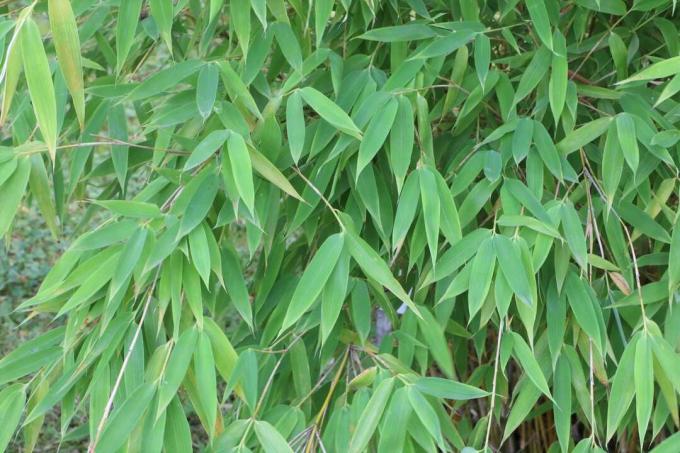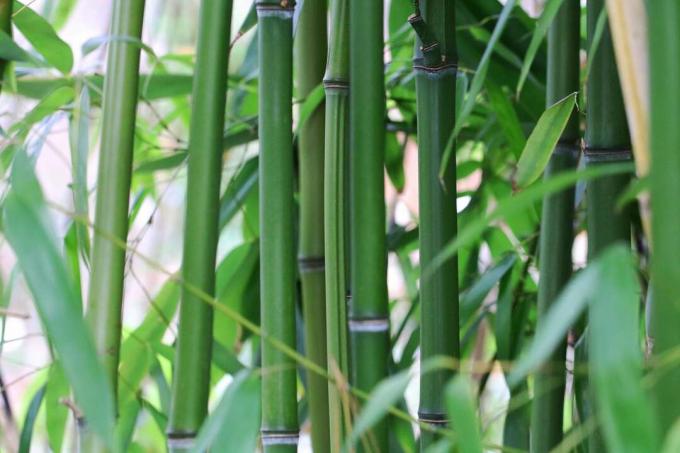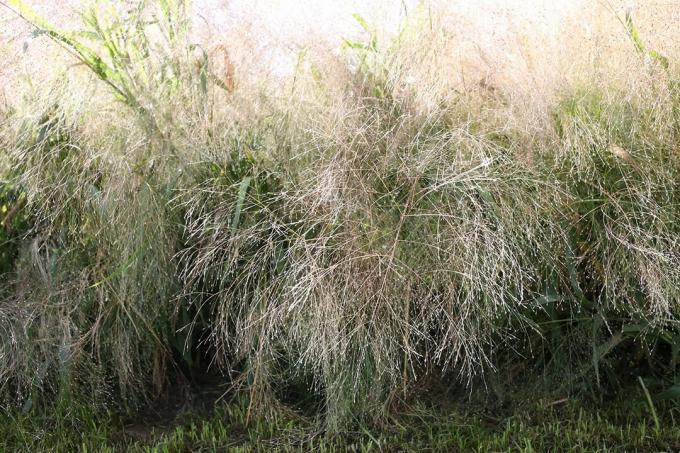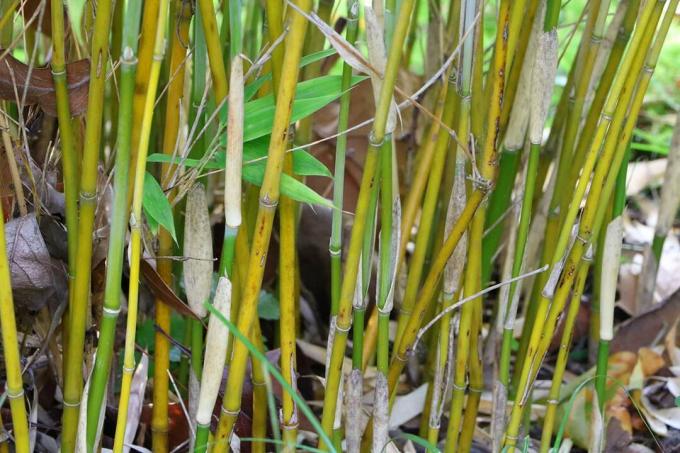

Table of contents
- Peculiarities of Fargesia murielae
- location and use
- Prepare the soil properly
- place plants correctly
- Care of the Muriel Bamboo
- Cut and clear
- Bamboo as a container plant
- Interesting facts about bamboo
Like all bamboo varieties, Muriel bamboo also belongs to the sweet grasses. This grass, native to south-central China, owes its name to the daughter of a British botanist, Ernest Wilson. Muriel bamboo reaches heights of between 1 and 5 meters and grows in dense clumps. The culms of this bamboo variety have a diameter of 0.5 to 1.5 cm. Up to 10 branches are formed at each node, at the end of which there are a maximum of 6 elongated narrow leaves (approx. 6 cm long) grow. Several cultivars of this bamboo are known, e.g. B. Standing Stone, Flamingo, Green Arrows and others
Peculiarities of Fargesia murielae
Two circumstances make this plant particularly popular with gardeners. The first advantage of Muriel bamboo is that the grass is hardy. This bamboo variety tolerates temperatures down to -28°C. The second important advantage of this bamboo is that it does not form rhizomes and therefore does not proliferate. Many bamboo species annoy garden owners by spreading uncontrollably. This does not happen with the Muriel bamboo, the growth of this plant can be controlled simply by pruning.
location and use
Like most grasses, the Muriel bamboo thrives best in sunny locations, but this variety also tolerates partial shade. The soil must not dry out, otherwise the leaves will turn yellow quite quickly and will not recover. Bamboo likes wind-protected locations, where the plant grows particularly luxuriantly. Because of its high growth, this bamboo is suitable for use as a hedge plant and also as a privacy screen, e.g. B. around the terrace. For this purpose, the individual eyries can be planted at a distance of approx. 100-150 cm apart. Muriel bamboo is a beautiful solitary plant that is very decorative, e.g. B. looks like the optical center of a front yard.
Prepare the soil properly
Although this beautiful bamboo variety is one of the easy-care plants, it still makes certain demands on the soil. The plant thrives best in the special bamboo soil. This soil can either be purchased or made up as follows: one third each of garden soil, compost and peat. Pine bark and clay granules can also be added. The granules increase the water retention of the soil. The Muriel bamboo basically likes nutrient-rich soils that are not too dry.
place plants correctly
Most bamboo plants are sold in containers. In order to place the plant correctly, a planting hole must be dug that is about 50 cm deep and approx. 40 cm wider than the container should be. The planting hole should be filled about 1/3 with the bamboo soil (or with the specially prepared mixture) and 2/3 with the “normal” garden soil. It is important that the bamboo is poured immediately and extensively, the amount of water can hardly be exaggerated.
Care of the Muriel Bamboo
The care of this plant is relatively easy and mainly consists of regular fertilizing with the bamboo fertilizer. Bamboo professionals believe that the best fertilizer for all types of bamboo is plain horse manure, which should already be composted. In any case, a high-quality bamboo fertilizer should contain nitrogen, phosphorus, potassium and silicon. The quantities specified by the fertilizer manufacturer must be carefully observed, because Muriel bamboo is sensitive to over-fertilization: Its fine leaves turn yellow and fall off. The plant should be fertilized as early as March, at a distance of approx. 4 weeks. The plant is also sensitive to waterlogging. Bamboo does not tolerate soil that is too dry either.
Cut and clear
The best time to cut Muriel bamboo is in spring, when the plant begins to sprout. The straws can be shortened by 1/3. Either a hedge trimmer or a secateurs are the right tools. It is best to cut about 1 cm above the respective knot. Through the cut, the plants grow denser and bushier, they are generally more vital. A tip: Shortly cut back old, partly yellowed stalks inside the bamboo hedge, then new living stalks will develop relatively quickly at this point. With older plants (over 5 years old) it is worth thinning out the stand and removing weaker, shorter culms. This is good for the plant and keeps it healthy. Pruning, the removal of the lower twigs on the bamboo, is more a matter of taste. It can be done on very tall plants. The goal is: to provide more light in the garden without removing the bamboo. In addition, it makes a plant look original.
Bamboo as a container plant
Several bamboo varieties are ideal as a container plant. The hardy Muriel bamboo can be grown in a tub all year round, e.g. B. stay on the terrace or in the driveway, but as a container plant, bamboo needs additional winter protection. Wrapped tightly in the fleece, preferably together with the tub, the bamboo survives the harsh winter in a wind-protected place. Otherwise, the usual bamboo care with fertilization and sufficient watering applies to the tub plant, whereby waterlogging should of course be avoided. The important difference in the care compared to garden plants is that the bamboo growing in the bucket should be thinned out more often.
Muriel bamboo is a fast-growing, low-maintenance plant that is not only suitable as a specimen plant, but also as a hedge plant and also as a container plant. The bamboo is hardy, but thrives best in sheltered locations. Planting in bamboo soil, regular fertilizing and watering contribute to the health and dense growth of Muriel bamboo.
Interesting facts about bamboo
Bamboo Fargesia murielae loves a semi-shady or shady location, but can also cope with sunny places if the humidity is high enough.
Bamboo Fargesia murielae needs some space. The higher the plant grows, the more space the roots need. At a height of 4 meters, about 10 square meters are required. Good soil is suitable garden soil. It should be fresh and moist. Humus and nutrient-rich soil is ideal.
Since the many leaves evaporate a lot of moisture, the plant has to be watered copiously. It does not tolerate drought. If you water too little, the leaves will curl up. Sufficient watering is also required in winter, but only in frost-free weather.
In the first few months after planting in spring or early summer, the bamboo is not fertilized. The plant needs to take root first. Then you fertilize once a month with nitrogen-rich fertilizer. Older plants should be fertilized from April and then until the end of June. The culms must become woody, otherwise they are not hardy. The plant should now stop growing so that it survives the winter well. If you mulch the bamboo well, you don't have to water as much and you don't have to fertilize as much.
In order to protect bamboo Fargesia murielae from drying out and frost in winter, you can cover leaves, straw or mulch sprinkle between the stalks.
A cut can curb the growth of this bamboo.
Bamboo Fargesia murielae is propagated by division in spring. You can also multiply the bamboo by sowing. The seed soil must not dry out, but it must not be too moist either. The germination period is a few weeks to a few months. The young plants should be overwintered frost-free for the first two or three years. An unheated stairwell or a garage with a window are well suited.
Bamboo Fargesia murielae is also suitable as a container plant. But you should make sure that it is overwintered frost-free.
Bamboo dies after flowering. Although it rarely blooms, if you have a bamboo hedge, you have to reckon with gaps. Almost never all plants will flower, so it will Hedge just thinned out.
 garden editorial
garden editorial I write about everything that interests me in my garden.
Learn more about ornamental grasses

cutting bamboo | When and how to cut back bamboo?
Be it as a hedge, solitaire or ground cover, bamboo can be seen more and more often in home gardens. Because the sweet grass is easy to care for and easy to grow. However, the latter can quickly become a problem if the plants are not pruned regularly.

11 Tips for Cutting Grasses | Tools & Co.
Cutting ornamental grass works best with our tips: From choosing the right tool to right time - we have the most useful tips and tricks for you for the annual grass cut summarized.

Switchgrass, Panicum virgatum: Care from A – Z
Switchgrass is an upright-growing, clump-forming grass with narrow leaves. The species is considered to be easy to care for and makes few demands on location and soil. Read how to optimally plant and care for Panicum virgatum.

Zebra grass, Miscanthus sinensis 'Strictus': care from A - Z
In botanical jargon, zebra grass is also called Miscanthus sinensis 'Strictus'. The plants can be used wonderfully as privacy screens and are decorative. From care in the tub to overwintering: You can find information on care from A - Z here.

Grow pampas grass from seeds: we explain how
Pampas grass is considered easy to cultivate and can be successfully propagated by breeding. Under controlled conditions in the planter, the germination success is higher than with direct outdoor sowing. The procedures regarding substrate, choice of location and care hardly differ in these variants.

Grasses as a privacy screen: 20 tall grasses
Numerous grasses are ideal as privacy screens! We present the 20 most popular grasses in this article!



